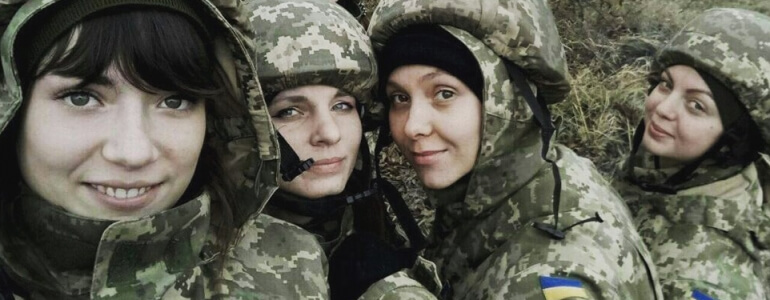Women at war. Problems of Ukrainian women fighters in the times of full-scale invasion
The Armed Forces of Ukraine have changed significantly since 2014. The impetus for the changes was the annexation of Crimea and Russian aggression in eastern Ukraine. The developments showed that the Ukrainian army was not ready to conduct full-scale combat operations against the enemy’s regular army. Since then, the Armed Forces of Ukraine have focused on reforms in all areas — weapons, equipment, uniforms, and nutrition. However, reforms related to the status of women in the army began as late as 2016. Then, a special order of the Ukrainian Ministry of Defence [1] increased the number of positions in enlisted personnel (private, sergeant, and sergeant-major) for women. In 2018, the Act on Amendments to Certain Acts of Ukraine on Ensuring Equal Rights and Opportunities for Women and Men during Military Service in the Armed Forces and Other Military Formations [2] came into force. The law aimed to officially enshrine the equality of men and women in the army — the list of positions was further expanded, and women could now be detailed for twenty-four-hour duty.
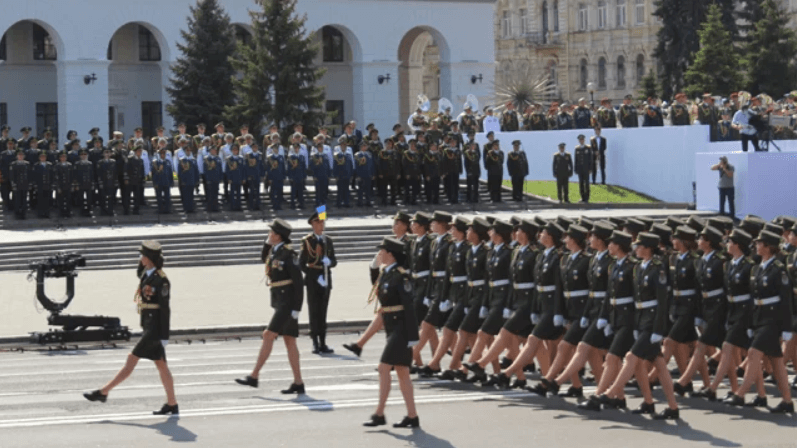
Servicewomen at the Independence Day 2021 parade
Before the full-scale Russian invasion, 32,659 women served in the Armed Forces of Ukraine [3]. That is, women made up one-seventh of the Armed Forces as of February 24. However, their visibility remained low. This article will discuss how the state’s policy towards women in the armed forces has changed over the 30 years of Ukraine’s independence, what challenges women have faced since the full-scale invasion, and whether they are currently being addressed.
Women and the army before 2014
It is impossible to analyse the situation of women in the army of independent Ukraine without a general idea of what happened in the Armed Forces before 2014. After the collapse of the USSR, the Ukrainian army changed a lot. In 1991, it was a powerful armed force that Ukraine inherited from the USSR. As of 24 August 1991, three combined-arms and two tank armies, an army corps, four air armies, a detached air defence force, a missile army, the Black Sea Fleet, two missile warning system nodes, 6,500 tanks, 7,000 armoured vehicles, 1,500 aircraft, 350 ships, 1,272 ICBM nuclear warheads, 2,500 tactical nuclear weapons, and about 900,000 personnel were deployed on the territory of Ukraine.
In the first years of the independence period, the Ukrainian army was one of the most powerful armies in the world. However, after the collapse of the Soviet Union, the state leadership, under pressure from Western countries, decided to give up nuclear weapons, and by 1996 Ukraine had become a fully nuclear-weapon-free state. Since the 2000s, under agreements with the EU and NATO, Ukraine has implemented several other programs for the disposal and destruction of weapons.
From 2010 to 2013, less than 1% of the budget was allocated for defence, and the number of Armed Forces personnel was constantly decreasing. In 2013, a contract soldier received a salary of UAH 1700, while the average salary in the country was 2700 hryvnias. Corruption and nepotism, so common in the army, did not contribute to the prestige of the Armed Forces. At that time, the level of confidence in the army ranged from 30-35%[4].
In October 2019, sociologist Hanna Hrytsenko analysed the situation of women in the army of post-Soviet Ukraine in a study for Gender in Details. According to expert Natalia Dubchak, whose data Hrytsenko relied on, women have served in the Armed Forces of Ukraine since 1991, but usually, they were wives, daughters, and other relatives of the military. Nevertheless, the number of female servicewomen has been growing every year, particularly among officers. For example, while in 2001 female officers accounted for 0.7% of all officers, in 2006 it was already 2.25%. The expert pointed out that this was because men did not want to take low-paid positions.
Hanna Hrytsenko noted in the study that the structure and logic of the army have not changed since Soviet times, and therefore provided for the displacement of women to operating and non-prestigious roles. The stereotype around “male” and “female” professions, which was persistently developed in the USSR, remained after Ukraine gained independence. Two articles of the Ukrainian Labour Code still prohibit women from heavy work and night shifts. In effect, this means that women do perform such work, but are not officially employed and therefore often receive lower wages.
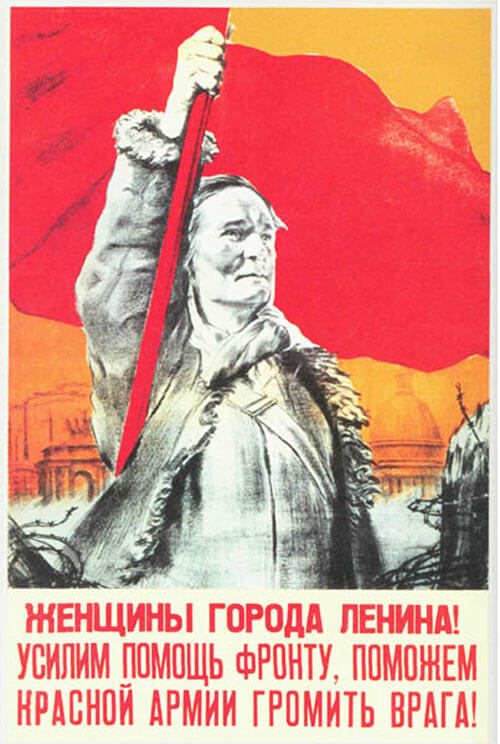
Soviet posters about women and war
At that time, women were granted military registration specialties under the Resolution of the Cabinet of Ministers of Ukraine “On Approval of the List of Specialties Allowing for Registration of Women in the Army” of 14 October 1994. The specialties were divided into seven categories: “Medical”, “Communications”, “Computer Engineering”, “Optical and Sound Measuring Instruments and Metrology”, “Cartography, Topography, Photogrammetric Mapping, and Aerial Photography”, “Printing”, “Movie and Radio Technicians”. That is, a woman in any case could not apply for any combat positions. All she could do was work as a cook, seamstress or medic.
The army is directly affected by the patriarchal nature of Ukrainian society. In 2013, the Ukrainska Pravda publication cited [5] the results of a study by the Research & Branding Group, which covered all regions of Ukraine. Respondents were asked to describe the traits of Ukrainian men and women. The following characteristics were mentioned in relation to men: courage and strength, ability to procure food, and intelligence. For women, the dominant characteristics were thrift, attractiveness, and the image of the home keeper. That is, the attitude towards women was purely patriarchal. Since the Armed Forces have been a closed and bureaucratic structure, especially until 2014, such attitude was most concentrated there.
2014 as a turning point
2014 was a key year for Ukraine, when dramatic changes took place in almost all state and public spheres. The Ukrainian army was largely unprepared for the annexation of Crimea and Russia’s participation in the war in eastern Ukraine. Therefore, powerful volunteer fighters and civil volunteer movements emerged in the country, in which women played a significant role. According to Deputy Defence Minister Hanna Maliar, in 2014, her agency recorded the first surge in the number of women in the Armed Forces [6]. The second occurred in 2022, after the full-scale invasion of Russia. In other words, women have also reacted strongly against threats to the state and military aggression, despite the still relevant patriarchal image of an exclusively male warrior figure.
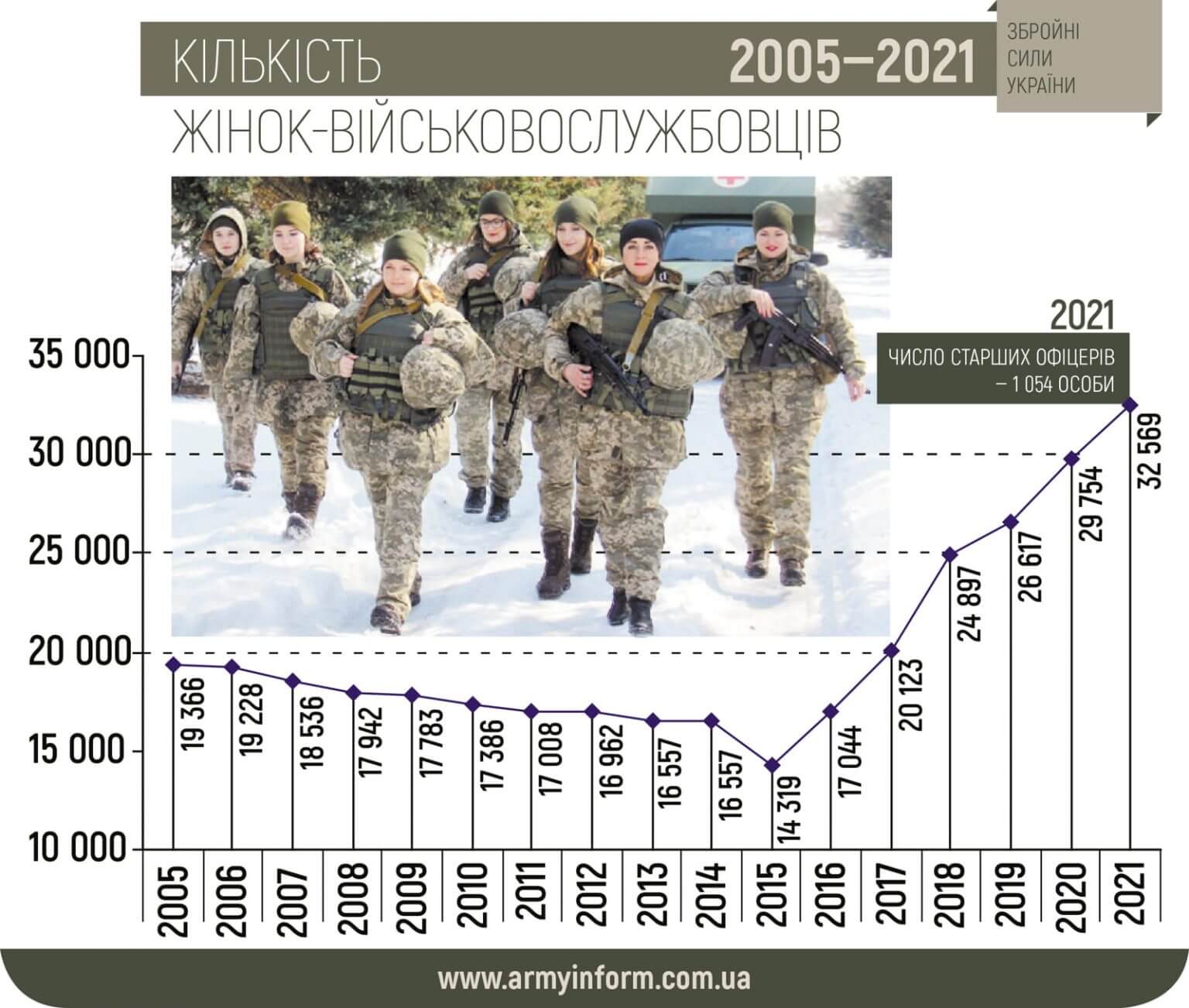
Number of women in the Armed Forces of Ukraine, 2005-2021
In 2021, the number of female senior officers amounted to 1054
Source: www.armyinform.com.ua
Women joined volunteer fighter battalions, volunteered in civil initiatives, and were mobilized into the Armed Forces. Alina Shevchenko, a resident of Kharkiv and a queer woman, was mobilized to the army in 2015, served in a combat unit, then signed a contract and now works at the headquarters, dealing with the registration of persons liable for military service. “At that time, it was not a very conscious choice for me, but little by little I came to understand what the Russian-Ukrainian war is. And I realized that the army is where I fit the most”, she says.

Ukrainian Armed Forces fighter Alina Shevchenko
In 2014, volunteer Yana Zinkevych founded the Hospitallers, the most famous volunteer medical battalion that participated in all the fiercest battles of 2014-2016. During the entire period of the battalion’s existence before the full-scale invasion of Russia, its medics saved 2,750 soldiers, and Zinkevych was awarded the third-class Order of Merit.

Yana Zinkevych
However, women are still facing problems. In 2015, in response to the challenges that women had to deal with, the Invisible Battalion movement emerged. Aerial reconnaissance specialist Mariia Berlinska was among the founders. It was the movement that initiated the abolition of legislation that banned women from holding combat positions. One of the main problems that women drew attention to was the “glass ceiling” that remained in the army. Even though in 2018 the positions unavailable for women in the Armed Forces were finally abolished at the legislative level, in practice, obstacles remained.
“We expected that the situation would level out and women would be recruited to combat positions, which they actually hold, and not as administrative support staff”, says Olena Shevchenko, head of the Insight organisation. “However, there are still a lot of such cases. It usually depends on the specific leadership of a particular battalion. Some of the commanders are not even aware of the fact that women can be registered differently. That is, the main problem is that the new legislation is something people do not know about, something that has not reached the ground.”
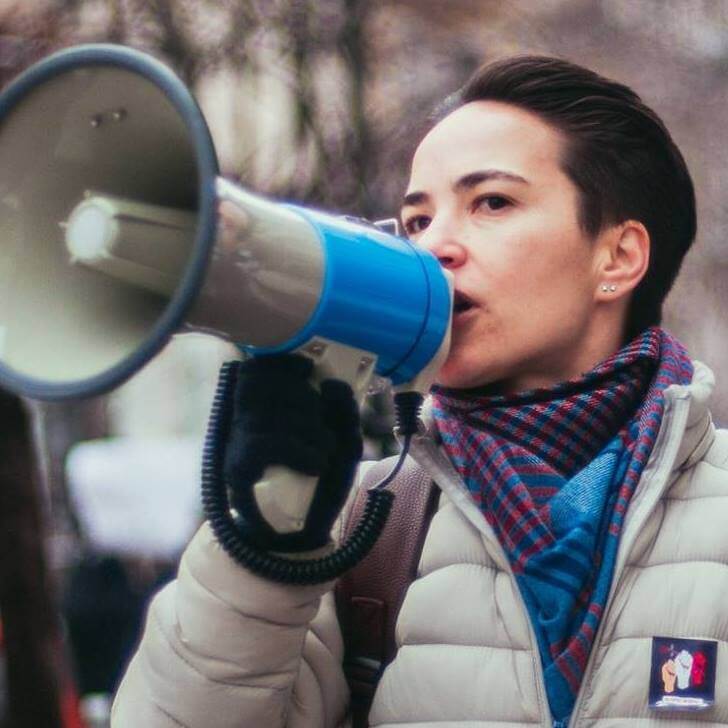
Olena Shevchenko
This is confirmed by Khrystyna Kit, the head of the YurFem Association of Women Lawyers of Ukraine. According to her, even after the full-scale invasion, the NGO receives reports of refusals to assign officer ranks and promotions.
In January 2019, the then Deputy Prime Minister for European and Euro-Atlantic Integration Ivanna Klympush-Tsintsadze said that the number of women in the Armed Forces of Ukraine was equal to that of NATO armies: “Women make 10.6% of our Armed Forces at the moment. This is very close to the average of NATO armies, which is 10.9%”. However, measuring purely by quantitative indicators is incorrect. NATO also promotes the role of women in the organizational structure. Women in the Alliance countries hold responsible positions — from chiefs of general staff to defence ministers.
In the history of Ukraine, there are only three female generals. In 2018, the first Ukrainian woman to receive the rank of Major General of the Medical Service was the Head of the Security Service of Ukraine (SBU) Military Medical Directorate Liudmyla Shugaley. In 2020, Volodymyr Zelenskyy promoted Yuliia Laputina, an SBU officer, to the rank of Major General, and in 2021, the first female Brigadier General, the Commander of the Medical Forces of the Armed Forces of Ukraine, Tetiana Ostashchenko, appeared in the Armed Forces of Ukraine.

Tetiana Ostashchenko, the third female general in Ukraine
Full-scale war of 2022: are women who defend the country visible?
In October 2021, the Institute of Mass Information conducted a study [7] and found that the media rarely mentioned servicewomen in their materials. While men were referred to in almost every article about the army or war, women were only mentioned in 5%. Today, the number of texts about women fighting at the front alongside men has increased significantly [8].
The media emphasize the importance and visibility of women in the Armed Forces. It is important that usually, these articles do not contain casual sexism and the widespread stereotype that “war is no place for a woman”. For example, in 2019, on the Fakty website, an article about women in the Israeli army was titled “War with a female face: how the fairer sex serves in the Israeli army”. A quick overview of materials after 24 February 2022 shows that expressions such as “the fairer sex” or “the softer sex” are no longer used.
This was greatly facilitated by changes in the symbolic sphere: in 2021, the name of Ukraine Defender Day, a public holiday celebrated on October 14, was changed to include both men and women [Ukrainian is a language with grammatical gender, and the basic noun form is usually masculine — trans. note]. Today, President Volodymyr Zelenskyy in his daily evening speeches addresses the defenders and volunteers at the front using both masculine and feminine endings in Ukrainian. This trend was picked up by the media and other officials. The use of feminine gender-specific job titles has become a common courtesy.
On 8 March 2022, the security agencies published reports where, contrary to the previous tradition, they did not promise to protect women, but celebrated the service of women in these structures.
Вітаємо з Міжнародним днем боротьби за права жінок і міжнародний мир усіх наших дружин, мам, сестер, подруг. Всіх українок.
— Держприкордонслужба (@DPSU_ua) March 8, 2022
Дякуємо, що зараз ви самостійно дбаєте про свою безпеку і безпеку дітей. Дякуємо, що підтримуєте нас, вірите в нас, в нашу країну! pic.twitter.com/xnqWU8sTr3

As in 2014, Ukrainian women are now involved in all aspects of the frontline actions. They stay in the units as volunteers and serve as combat medics, infantrywomen, snipers, and machine gunners. Some of them are well-known bloggers who have used their media to help the army. Singer and presenter Anastasia Shevchenko, also known as “Stasik”, returned to the ranks of the Armed Forces after February 24. In 2014, she was a combat medic and a self-aid and buddy-aid instructor. Stasik uses her media presence to collect donations for the units. Her 2019 song “Lullaby for the Enemy” with the lyrics “You wanted this soil, so mix with it” became a kind of anthem of the fight against the enemy.
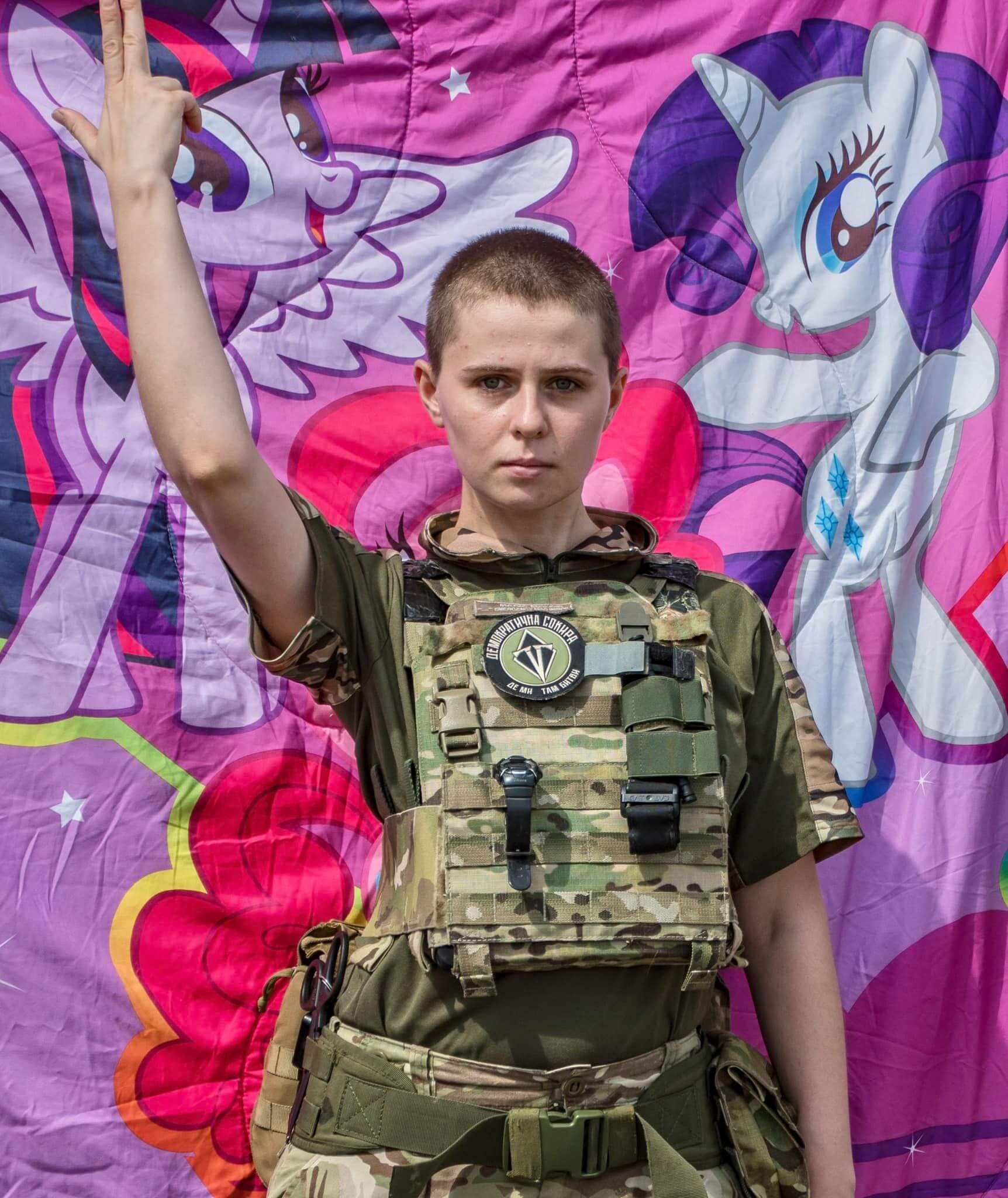
Anastasia Shevchenko
Tactical medicine instructor and combat medic Mariia Nazarova is a co-author of tactical medicine training programs of the General Staff of the Armed Forces of Ukraine. In eight years, she has trained some 8,000 military personnel. Now Nazarova conducts trainings for military and civilians and is actively engaged in an information campaign to debunk myths about tactical medicine
Mariia Nazarova explains the differences between Russian and Ukrainian first aid kits
Yaryna Chornoguz has been serving in the Armed Forces of Ukraine as a combat medic for two years. In her blog, Yaryna tells a lot about her service experience and frontline everyday life and shares her thoughts on the status of women. This also significantly raises and normalizes the visibility of women at war.
Many women joined the army to defend their country for the first time. One of them is Lesya Ganzha, the former editor of the feminist publication “Women are 50% of Ukraine’s Success”. On 24 February, she enlisted in the territorial defence unit in Kyiv’s Obolon district and guarded infrastructure facilities in Irpin during the fighting near Kyiv. “Many men, in the battalion, in particular, ask: ‘Why did you come here?’”, shares Lesya. “Some have no such questions, which is already a big deal. ‘Why do you need this?’ And I say, ‘Why do you need this?’ The man would immediately reply: ‘Well, I want to protect Ukraine’. So I say, ‘I am also here to defend Ukraine, I am a citizen like you’. Many people start thinking about it and admit I am right”[9].
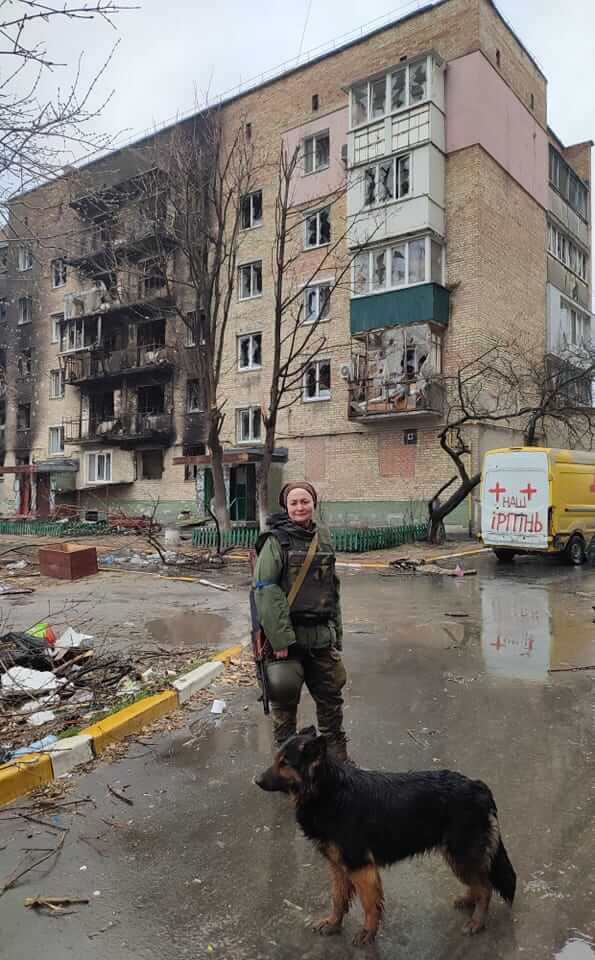
Lesya Ganzha in Irpin in March 2022
Women in captivity
According to the UN, during the war, women are one of the most vulnerable groups, they make up 54% of people who need help because of war. This applies to both civilian and military women. First of all, it is about becoming a prisoner of war.
In 2019, an article about women who were captured by the LDPR terrorist organizations [10] was published in the Novoye Vremya newspaper. They said that sexual violence against women in captivity is a common practice. Similar sexual crimes also occurred at checkpoints at demarcation line crossings, the Government Commissioner for Gender Policy Kateryna Levchenko told the publication. In addition, there was information about militants establishing brothels and bringing women there to forcefully engage them in prostitution.
Sexual violence is another weapon in war, an element of psychological pressure and intimidation. Not only it is a criminal offence, but also a violation of international law. During Russia’s full-scale invasion, human rights activists and government agencies have been constantly recording information about sexual crimes against Ukrainian women. These are both crimes against civilian women and those in captivity. Deputy Prime Minister for Reintegration of the Temporarily Occupied Territories of Ukraine Iryna Vereshchuk said in April that she received information that some women prisoners of war were raped.
In mid-March, Russians captured a volunteer and military medic Yuliia “Taira” Paievska. The woman spent over three months in captivity. This is what she said: “More recently, I was kept in Donetsk detention centre. There are a lot of our prisoners there. The treatment is terrible. They fed us good enough to not let us die of hunger. But last week, we were not even given soap. There were 22 women in the cell, three by six meters, ten beds”[11].

Yuliia Paievska in the first days upon release from captivity
Russian propaganda created a powerful propaganda myth around Taira, portraying her as a Nazi and a murderer who ruthlessly killed children and women. A significant aspect of the myth was the fact that Yuliia was a woman. The patriarchal stereotype of women as gentle, soft creatures reinforced the effect of the lie.
In April, Ukraine returned 15 female servicewomen from captivity. All of them had their heads shaved. This is another way to humiliate women. The invaders also resort to psychological pressure on women, blackmailing their relatives and children. Here is what Taira said: “Other [women] also had no information about their families and children. There were Ukrainian women from the Armed Forces and the National Guard, girls from the Azov battalion, and civilians”.
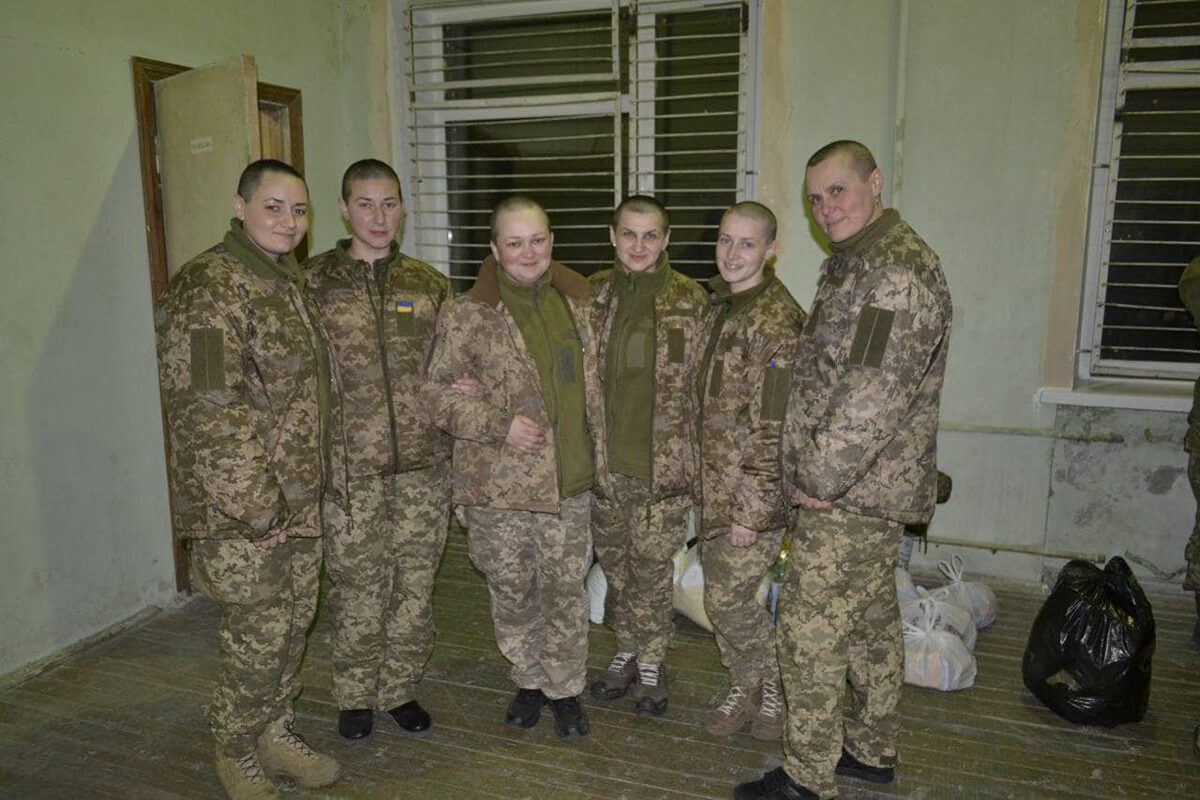
Ukrainian women who returned from captivity in April
After the return of 15 Ukrainian women from captivity, Iryna Vereshchuk announced that the figure of Ukrainian servicewomen remaining in captivity at that time amounted to 500 people. It is not reported how many women are held in captivity now. Their number has increased significantly, especially after the last defenders of Azovstal were captured in May. The fate of 82 captured women medics from Mariupol is unknown. Doctors, nurses, and Mariupol military hospital staff have been in captivity since April 12.
The issue of Ukrainian women prisoners of war is not sufficiently covered in the media and is not broached in the international arena. International feminist organizations should assist Ukraine in this issue and extensively push it. The publicity alone will help women in captivity to survive.
Women’s military uniform and hygiene — what is lacking in the army
As of today, according to Deputy Defence Minister Hanna Maliar, some 50,000 women serve in the Armed Forces of Ukraine. Of these, about 5,000 serve on the front line, and 12,000 are civilian women who joined the army and hold civilian positions. Since 24 February, the number of female soldiers has increased by 7,000. One of the problems they face is the lack of female uniforms. Ukraine has approved a single standard of uniforms, which is a male one. Currently, only the ceremonial uniform is available in women’s sizes. Therefore, servicewomen have to alter their uniforms, pinning or adjusting them with a tactical belt in the field.
“If the uniform fits in size in the hips, the breasts may not fit; if it fits in the waist, the hips do not fit”, explained Kyiv City Council deputy Iryna Nykorak. “90% of women adjust it with the help of a seamstress, if there is one in the military unit, or at their own expense. In the field, it is not always possible to hem it”[12].

Iryna Nykorak shows why men’s uniforms do not fit women
“The issue is complex, and it lies in the fact that women’s problems are not taken into account in any sphere”, says Olena Shevchenko. “From underwear on down to bulletproof vests and helmets. A bulletproof vest that is not the right size is generally very harmful because the back suffers, there may be bruises and swelling”.
Strangely, the issue of uncomfortable military uniforms has not been raised until this year. While the men’s uniform, in particular the field uniform, has been constantly changing and improving since 2015, only the ceremonial uniform was changed for women in 2019 to bring it in line with the new standards of the Armed Forces of Ukraine. This may also implicitly indicate that women in the Armed Forces were not considered full-fledged combatants who need comfortable uniforms for successful service.
Meanwhile, some NATO and other countries’ armies have women’s military uniforms. In Israel, where women are drafted into the army on an equal footing with men, the issue of women’s uniforms has been quite complicated for decades. Women did not hold combat positions, so instead of berets they wore field service caps, skirts instead of trousers, shoes instead of boots, says Israeli army officer Yigal Levin. In the 1970s and 1980s, feminist movements forced a revision of the policy on women’s uniforms, and since then women have been wearing regular military uniforms, although they can choose skirts and shoes if they wish. Although the women’s uniforms in Israel are sewn according to slightly different designs, Yigal Levin says that women still alter the uniforms to more refined shapes, even though it is officially forbidden.
One of the best approaches to women’s military uniforms is implemented in the United States. In 2009, the US army began to design special tactical gear for women. Currently, the US armed forces have a database containing 93 parameters and 3D scans of male and female bodies. They are instrumental in achieving the perfect comfort of uniforms, body armour, backpacks, and even car seats. In 2018, the US Army approved a new body armour system — the Modular Scalable Vest (MSV). It is less weighty, does not hinder movement and is adjustable to any size and shape.
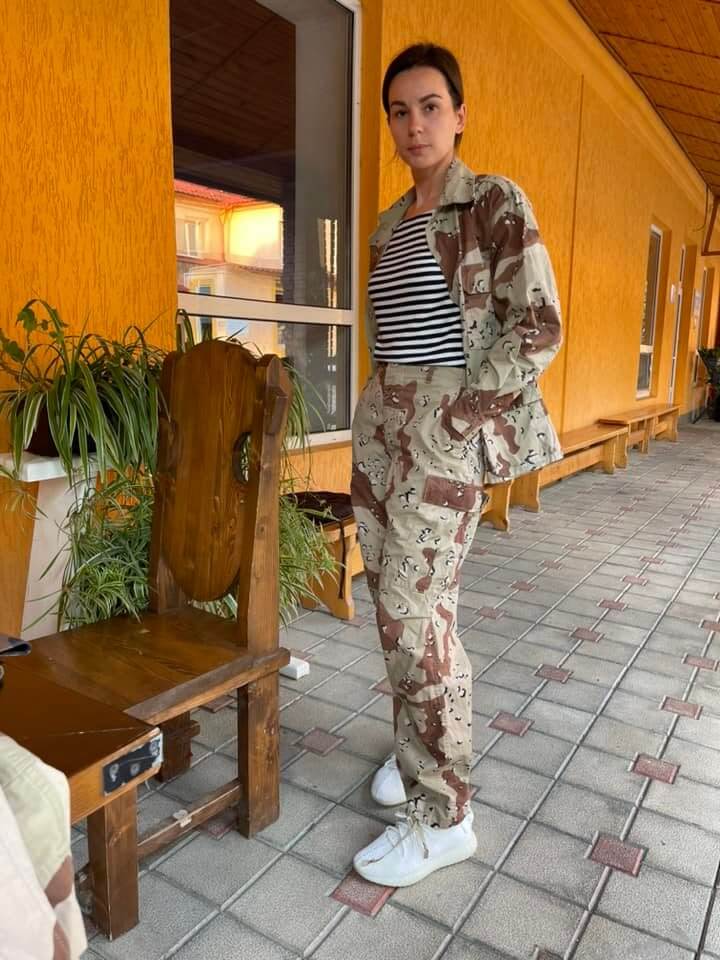
Iryna Nykorak wears US women’s military uniform
Currently, uniforms for women in the Armed Forces are made by volunteers. One of the main projects, ArmWomenNow, was founded by Iryna Nykorak. US Army uniform designs were taken as references. Unfortunately, this is a pure volunteer project, and the money for its implementation is raised by donations. In July this year, the Ministry of Defence told the Ukrainian BBC service that it works with two action groups. The first is a group of volunteers supported by the Presidential Office within the First Lady’s project “No Barriers”. The second is Nykorak’s project. The agency said it had met with both groups and offered to test experimental designs in the field[13].
“Uniforms for women are still not produced in a centralised way”, says Olena Shevchenko. “There is a company that sews uniforms for the Armed Forces at the request of the Ministry of Defence — for men only. It is necessary to change this process at the management level, hold a tender and produce uniforms designed for both women and men. This is a rather long process for the Ministry of Defence. The main task is to speed it up”.
In addition to uniforms, women face gender-specific problems in military field life. First of all, it is the lack of access to sanitary protection and menstrual pain. So far, this issue has not been solved at the legislative level, so women have to provide themselves with everything they need on their own.
Sexual harassment in the army
In 2018, Lieutenant Valeria Sikal reported that she had been harassed by A-1358 military unit commander Viktor Ivaniv. This was the first public statement about harassment in the Armed Forces of Ukraine. However, the criminal case on Valeria’s allegation was never brought to court, and Viktor Ivaniv was not dismissed. The first case that resulted in real action — the dismissal of the accused — took place in January 2021. Lieutenant Colonel of the Armed Forces of Ukraine Olga Derkach stated that she had been sexually harassed during the service by her superior, regional military commissar Oleksandr Kryvoruchko. Kryvoruchko was fired.

Valeria Sikal
Sexual harassment in the army remains one of the taboo subjects. In September 2020, the Kyiv International Institute of Sociology together with the Invisible Battalion conducted a survey to find out how people feel about harassment in the Armed Forces[14]. Some 20% said that it is an important but silenced topic. 56% of respondents said that this topic should be raised in the public sphere, and 7% believed that it harms the image of the Armed Forces.
Olga Derkach noted that she had endured harassment from Kryvoruchko for many years — they served together since 2009. However, the woman did not dare to voice the issue for a long time. She believes fear is one of the reasons for being mute: “There are many factors in play. They are afraid because there may be some pressure at work. They are ashamed and do not even share it with their family. A female friend told me: ‘If my husband finds out, I will end on the street, he will divorce me'”[15].
According to the head of Insight Olena Shevchenko, the organisation still receives complaints about sexual harassment, but those are sent by friends and acquaintances, instead of survivors themselves. Insight has received a dozen of such requests. “As a rule, the commander makes sexual advances on a woman and demands some sexual favours”, says Olena.
Khrystyna Kit, head of the YurFem Association of Women Lawyers of Ukraine, notes that they have also received reports of harassment perpetrated by commanders and servicemen. “As a rule, these reports were not related to the fields where active military operations were taking place”, she adds. “Because those in flashpoint areas have no time for that, unlike those staying in military units. In particular, we are talking about the western and central regions that are far from active operations”.
Khrystyna Kit also mentioned that even if a woman is ready to testify about harassment, it is often difficult to bring the case to court. “In some cases, there are no witnesses to the act of harassment and there is no one to confirm it except the survivor herself”, she explains. “Therefore, bringing the perpetrator to account is a complicated and traumatic procedure for the survivor”.
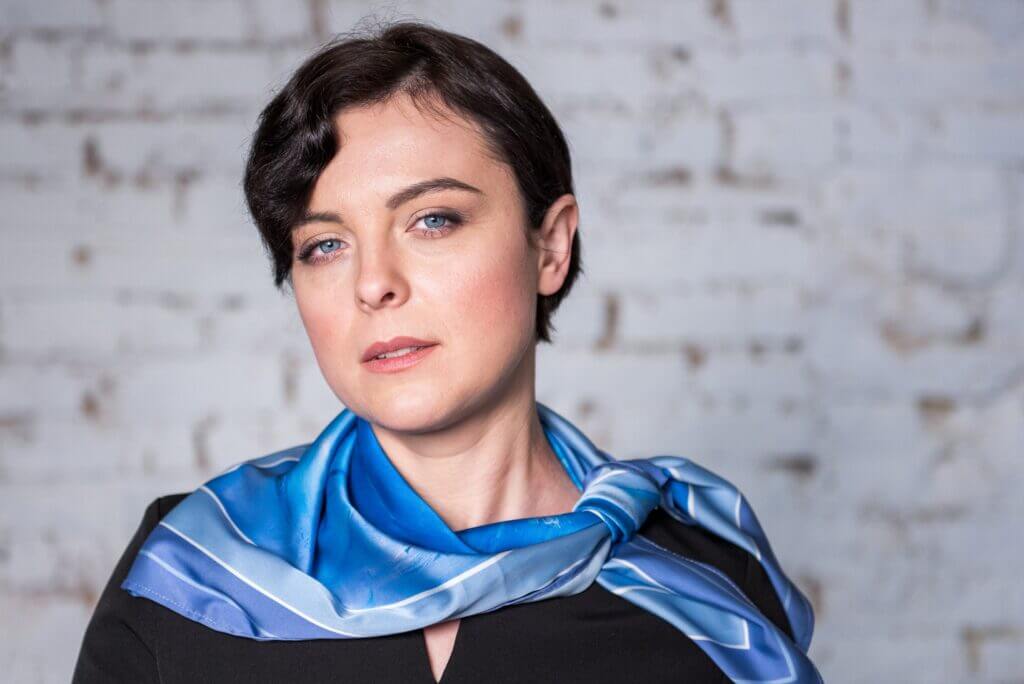
Khrystyna Kit
According to Khrystyna Kit, internal investigations of such crimes would be more effective. In March, Viktoria Arnautova, adviser to the commander-in-chief of the Armed Forces on gender issues, told Radio Liberty that this issue is the focus of attention. “We are studying legislation, analysing internal documents, and learning about the means to best develop this mechanism, which would include ways to file complaints and protect the rights of participants in the process. We need to launch such mechanisms as confidentiality and anonymity, the ability to consider cases without disclosure. This is a very stigmatised area both for the Armed Forces and the whole society”, she explained. So far, this mechanism is not implemented. Meanwhile, the investigation initiated by filing a complaint with law enforcement agencies often does not yield satisfactory results for the survivor.
Conclusions
The Ukrainian army cannot change independently of the Ukrainian society — on the contrary, the more changes that take place in the society, the faster and better they will find their way to the Armed Forces. In eight years of reforms, the position of women in the Armed Forces has changed a lot. The number of women in the army has increased significantly, and they finally began to occupy not only stereotypical “female” positions, but also combat ones. However, women remain the most unprotected people in the army structure. The general patriarchy of Ukrainian society is superimposed on the closed and bureaucratic nature of the army.
Alina Shevchenko, who has been serving in the Armed Forces for seven years, says that women in the army are still treated with bias. “I have repeatedly faced situations when I was treated condescendingly”, she says. “Condescension can be applied to both men and women. But when you want to do something and you are told ‘stay out of it, it’s not a woman’s job’, it’s painful. For some reason, these social constructions are still in place”.
This applies, in particular, to sexual orientation. Alina did not hide from the team that she is a lesbian and has a female partner, and before that she used to go on dates with girls. She has not faced open condemnation or bullying because of her coming out, but this is also due to prejudice against women, reckons Alina. After all, there is a stereotype in society that a woman’s love for a woman is “aesthetically pleasing”, while love between two men is “outrageous”.
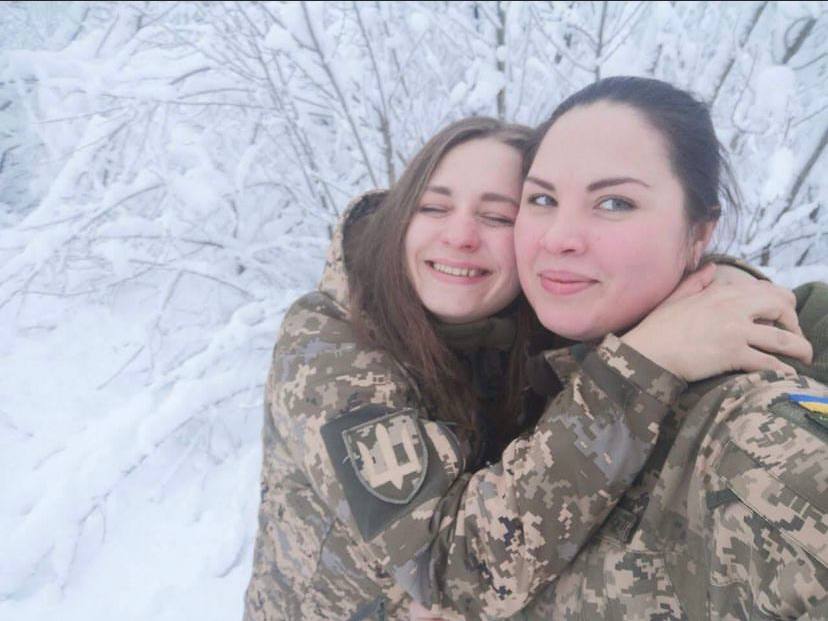
Alina Shevchenko with her sister-in-law
“Our society needs sex education, which is not available at the general level”, reflects Alina. “The same applies to other spheres of life. When the Istanbul Convention was finally ratified and we discussed it, I saw that many people do not understand what it is and why it is needed. They are guided by stereotypes. You start explaining, and they can gradually change their mind. I hope that the full-scale invasion will help us to change the situation”.
[1] Temporary list of military specialties of privates, sergeants and non-commissioned officers of the Armed Forces of Ukraine: https://zakon.rada.gov.ua/laws/show/z0600-14#n14
[2] The Act on Amendments to Certain Laws of Ukraine on Ensuring Equal Rights and Opportunities for Women and Men in Military Service in the Armed Forces of Ukraine and Other Military Formations: https://zakon.rada.gov.ua/laws/show/2523-19#Text
[3] Скільки жінок-військовослужбовців служать у Збройних Силах України — нові дані Кадрового центру [How many military women serve in the Armed Forces of Ukraine? New data from the Personnel Center] // Army Inform, 04.12.2021: https://armyinform.com.ua/2021/12/04/skilky-zhinok-vijskovosluzhbovcziv-sluzhat-u-zbrojnyh-sylah-ukrayiny-novi-dani-kadrovogo-czentru/
[4] Динаміка ставлення населення до соціологічних опитувань, листопад 2013 [Dynamics of the population’s attitude to opinion polls, November 2013] // Kyiv International Institute of Sociology, 23.12.2013: https://www.kiis.com.ua/?lang=ukr&cat=reports&id=218&page=3&t=11
[5] В Україні зафіксували гострий дефіцит справжніх чоловіків [An acute shortage of real men was recorded in Ukraine] // Ukrainska Pravda, 16.05.2013: https://life.pravda.com.ua/society/2013/05/16/128600/
[6] Другий сплеск після 2014: скільки жінок служать у ЗСУ і скільки з них — на передовій [The second surge after 2014: how many women serve in the Armed Forces and how many of them are on the front line] // Channel 24, 24.06.2020: https://24tv.ua/drugiy-splesk-pislya-2014-skilki-zhinok-sluzhat-zsu-skilki-nih_n2103822
[7] На згадки про жінок-військовослужбовиць у медіа припадає лише 5 % — дослідження ІМІ [References to servicewomen in the media account for only 5% — IMI research] // Institute of Mass Information, 15.10.2021: https://imi.org.ua/monitorings/na-zgadky-pro-zhinok-vijskovosluzhbovyts-v-media-prypadaye-lyshe-5-doslidzhennya-imi-i41836
[8] Maria Prymach. Войовниця, волонтерка, активістка: як змінився образ жінки в українських медіа після повномасштабного російського вторгнення [Warrior, volunteer, activist: how the image of women in Ukrainian media has changed after the full-scale Russian invasion]. Student research // Mediakrytyka, 30.06.2022: https://www.mediakrytyka.info/ohlyady-analityka/voyovnytsya-volonterka-aktyvistka-yak-zminyvsya-obraz-zhinky-v-ukrayinskykh-media-pislya-povnomasshtabnoho-rosiyskoho-vtorhnennya-studentske-doslidzhennya.html
[9] Моїй дитині вже 25, тому ми разом зібралися і пішли у військкомат — журналістка, яка вступила до тероборони [My child is already 25, so we went to the recruitment office together: A journalist joined the territorial defence unit] // Hromadske Radio, 13.04.2022: https://hromadske.radio/podcasts/40-novi-20/moiy-dytyni-vzhe-25-tomu-my-razom-zibralysia-I-pishly-u-viys-kkomat-zhurnalistka-iaka-vstupyla-do-teroborony
[10] Iryna Lopatina. «Вони описували, як помре моя донька». Історії жінок, які пережили насильство і полон бойовиків «Л/ДНР» [“They described how my daughter would die”. Stories of women who survived violence and captivity by L/DPR militants // Novoe Vremya, 19.05.2021: https://nv.ua/ukr/ukraine/events/donbas-poloneni-zhinki-shcho-stali-zhertvami-nasilstva-reportazh-novini-ukrajini-50060988.html
[11] Taira: captivity, Mariupol, the future of Ukraine // https://www.youtube.com/watch?v=XVGBT6jkAks
[13] Viktoria Prysedska. Офіційна жіноча військова форма. Як ЗСУ роблять ще один крок до рівності в армії [Official women’s military uniform. How the Armed Forces are taking another step towards equality in the army] // BBC, 18.06.2022: https://www.bbc.com/ukrainian/features-62148100
[15] Nadiia Konstantinova. Переведення в бригаду «через постіль». Чому мовчать про сексуальні домагання у війську? [Sleeping one’s way to the brigade. Why are women silent about sexual harassment in the army?] // Radio Liberty, 06.03.2021: https://www.radiosvoboda.org/a/seksualni-domahannya-u-viysku/31133935.html
This article was originally published in Ukrainian here
Nothing beats good old email
For our monthly newsletter, we pick the most important news and analysis,
and add selected content and art from queer creators.
